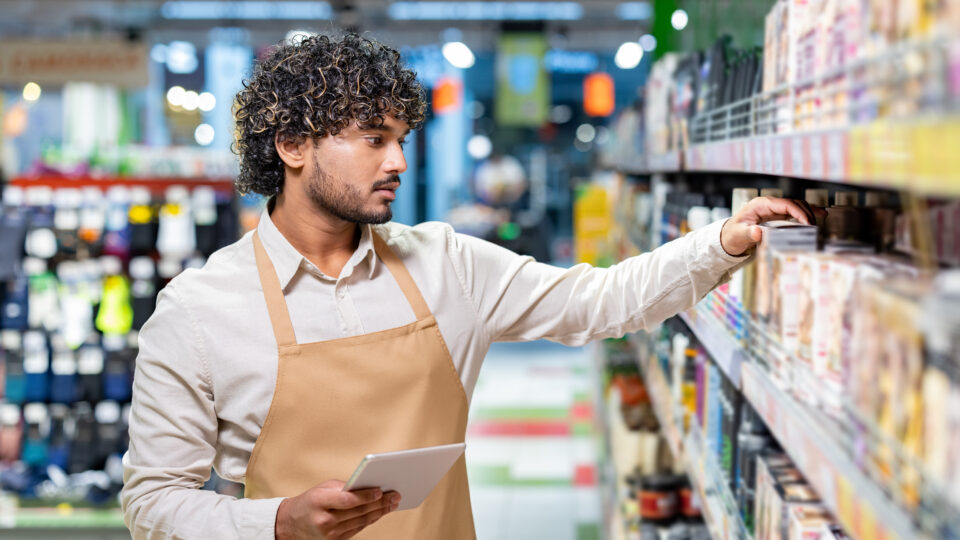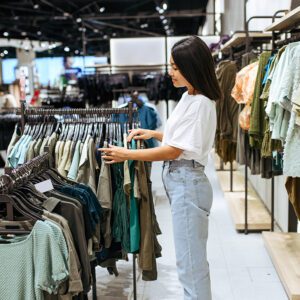As one of the industry’s largest providers of retail technology, Aptos is intimately attuned to retailers’ challenges and needs. This year at the company’s series of Engage Direct retailer conferences, Aptos’ VP of Strategy and Product Nikki Baird touched base with more than 60 of those retailers to learn about their current technology priorities and pain points.

Baird sat down with Retail TouchPoints to give us the inside scoop on the big themes that came out of those conversations, which paint a picture of where retail technology is headed, including:
- Mobile POS is no longer an Apple Store-only phenomenon, but there are still barriers to creating a holistic experience that connects the back and front of store;
- Amid the enthusiasm for all things AI, important security and compliance considerations are often being overlooked;
- RFID’s multi-purpose utility is slowly gaining more and more proponents across the industry, especially as the cost of the technology decreases; and
- Retailers won’t be able to “rinse and repeat” their back-to-school strategy this holiday season.
Retail TouchPoints: So what were the biggest takeaways from Engage Direct?
Nikki Baird: Mobile in the store definitely seems to be a renewed focus area. It’s kind of like RFID, because I feel like I’ve said it so many times — “Now they’re finally investing in mobile in the stores” — but it does really feel like mobile is an impetus driving technology refresh in stores right now. Retailers want mobile to be more closely integrated into the role of the store employee and store manager. They have long complained about how Apple is a different kind of experience and that they can’t be cash wrap-less [like Apple], and yet now I do see many rethinking and really shrinking down that cash wrap and wanting the store associate to be out in front of the cash wrap instead of behind it.
I still see some analysts in the industry who distinguish between fixed-till versus mobile, and with tablet formats it really can be both. In fact, a lot of the drive behind mobile now is not employee productivity so much as it is reducing the hardware footprint in stores. They need fewer devices, and they need devices that can be multi-purpose. [With mobile you] can have a shared cash drawer [instead of] a big till that’s a full tech stack of receipt printer, cash drawer, scanner and all those peripherals. And that does seem to be what’s driving this renewed interest in [mobile tech] — that there’s no distinguishing between fixed-till versus mobile, it’s all the same devices.
One interesting thing that we’ve seen come out of this interest is that Apple is winning the front of store and Android is winning the back of store. So when it comes to inventory management, rapid-scan receiving, cycle counts, even picking orders for omnichannel, the preferred format is that traditional retail-hardened Zebra kind of device. They like that for the back of store, but for the front of store, they like the Apple sleekness and the feel of that experience, especially when they’re standing side by side with the customer.
And I will also say, we’ve heard very strongly that the device management needs now are exponentially larger, and they haven’t found a good solution for managing both Android and Apple.
RTP: Does that mean you feel like retailers have to pick one or the other at this point?
Baird: No, they are definitely forcing it through and saying, “I’m going to do Android in the back and I’m going to do iOS in the front.” What that forces on them is two mobile device management solutions, so one for the back of the store and one for the front, and it’s not giving them a holistic picture of the store environment.
I was actually amazed; we’ve been trying to find partners that we can recommend to help [our clients since] we don’t do mobile device management, but a lot of the hardware providers do. But if you buy HP tills, you get HP MDM [mobile device management], and if you buy Apple then Apple has partners they’ll recommend, but it’s not HP, because they compete.
They are putting a lot more intelligence into MDM, and it really would be a great benefit to the retailer to have that more holistic [front and back of store] view. [These MDM systems], for example, when you plug a device in, will run diagnostics to tell you if a device needs to be replaced or a battery is starting to fail. I’ve seen systems where an employee will badge in to check out a phone or a tablet and it will tell them which tablet to use, so that they rotate through and aren’t just using the first five devices. That way, the batteries get cycled and last longer. They also can send an alert, “This employee clocked out, but this device wasn’t checked back in.”
RTP: All that really speaks to the complexity of what retailers have to manage with this technology. Do you think the renewed interest in mobile systems also is being prompted by the growing prevalence of AI assistants for customers and associates?
Baird: I’ve seen a whole range of enthusiasm. So on one level, there are the retailers who have a spaghetti approach — throw everything at the wall, see what sticks. They’re still prioritizing things that are not risky necessarily, like the employee SOP [standard operating procedures] manual or the help documentation for their POS software, and making that something you can query in natural language and get answers back. Product recommendations also are kind of low-key risk. If you get it wrong, then they don’t buy, but it’s not like you’ve exposed anybody’s personal information.
I do think, especially when you get into customer data then we will see more of a push for a local model on a device and not sending that data over the cloud, even within a retailer’s network. If you can have a local language model on the device, and you can have that interaction at the local level, then the security profile is much more manageable.
RTP: It sounds like the security and privacy factors are increasingly top-of-mind.
Baird: We’re in compliance training season, and I’m taking the EU AI compliance training, and let me tell you, anything that uses consumer and personal information in the EU is going to be a constraint. We actually have some retailers that are instituting AI Approval councils. So the retailer is saying, “If you have an AI initiative, you have to put together what it is, what data it’s using, how it’s using that data and what kind of result it’s going to return, and you have to submit it to the committee for review, and it has to be approved before you can go off and do it.”
A lot of what’s driving that is the concern over the EU compliance, as well as “surveillance pricing,” which is suddenly becoming a huge term, and personalized promotions. I do think it’s going to slow down some of the [AI implementation], because they have to be careful of all of these new regulations that are going into effect and that really affect informed consent — in the EU if you’re going to use consumer data for some kind of AI response, you have to inform them that you are doing that and give them the opportunity to opt out. Also, if there’s anything that gets to the level of personal safety or is medical-related, there’s a whole new class of regulation that comes into effect in the EU.
RTP: You mentioned RFID as another of those technologies that has seemed to have so much promise for so long that many in the industry have been waiting for RFID to have its moment. Is that moment here?
Baird: What’s really driving it this time around is omnichannel. Before, retailers were setting a safety stock level in their store so that they weren’t promising something to an online customer that they didn’t actually have. “If my store says I have five, I will say I have three, because one of them might be damaged or one of them might be walking around in a customer’s cart.” RFID gives that opportunity to know if an item is really available or not. And yes, it could still be fudged, it could be walking around in a customer’s cart, but there’s a much smaller risk. So that idea of knowing, down to the second, if I really have this item that I can promise a customer online seems to be what’s driving [the increased uptake in RFID].
Also, a lot of the brand manufacturers have moved to RFID tagging at the source, which gives even multi-brand retailers the opportunity to participate. We have a client who’s a multi-brand shoe retailer, and they said that 70% of their inventory shows up on their doorstep already tagged. At that point it’s like, shouldn’t we try to do something with it? Even if you can only do it with these brands, if I [as the retailer] can promise every single Nike shoe I have, I should try.
People assumed that you needed to have absolutely everything tagged before you could really get the benefits of RFID, and we’re seeing now that that’s not the case. You can build a business case even if you have partial tagging, because you can use the visibility that you have for the items that are tagged to justify the expense of tagging the rest of the items.
Then [other benefits] come in a really quick one-two punch: they tag everything, they put the readers in their stores — which have gotten a lot cheaper, so that’s also helped — and then they say, “Okay, now I can do the omnichannel stuff. What I really want is [to increase] the speed of checkout.” So they go from inventory management to checkout experience really fast.
There’s also been a lot of developments around loss prevention and integrated electronic article surveillance (EAS) with RFID that have gotten interest from retailers. So you can have that EAS now without having to have the big clunky tag that has a battery in it. You can do it with a regular NSC-chip RFID tag. And it gives them other advantages; for example, if the consumer returns an item and the tag is still attached, they can just reactivate that same tag, so it cuts the cost of maintenance a lot.
RTP: Every time somebody talks to me about RFID I always end up wondering why everybody isn’t using it, Is it really expensive to institute?
Baird: It’s like a cult. I hate to describe it that way, but it’s true. If have a room with 50% of people who use RFID and 50% who don’t, the 50% who are using it, they drank the Kool Aid and they are trying to get the other 50% to drink it. And that other half are like, “I don’t believe that you’re getting those benefits.”
It’s almost like you have to experience it before you really see how it is a different world. That’s the biggest barrier, but as we get more people who have come from an RFID environment and move to retailers that aren’t doing it, they’re really pushing it to where it’s almost spreading organically.
RTP: You mentioned that the cost of the readers has gone down. Has the cost of the RFID tags come down as well?
Baird: It has come down, but honestly at this point the business case is not about the tags themselves. It’s about the readers and the kind of coverage you get in the store.
A lot of [the expense] comes from the retrofit of the store. If the store wasn’t designed for RFID, then the retrofit can be expensive. But we had a lot of retailers who remodeled for omnichannel to better support pickup in-store or fulfillment from the store, and when they did that, some of them were thinking about how to wire the store better, have more access to power, have more WiFi access points.
RTP: What have you been hearing from the back-to-school trenches, and do you think retailers should be planning similar strategies for holiday — or will they need a different approach?
Baird: There will need to be a different approach [for holiday]. What we saw from our surveys was consumers saying, “I’m going to cut back specifically to preserve back-to-school spending, because I don’t want my kids to feel the uncertainty. So I’m not going to dine out, I’m going to buy my kid’s first-day outfit.”
That’s definitely a cautionary note. When it comes to holiday, there’s a lot more pressure to travel, and so that balance of, “We’re going to go see grandma for Christmas, so it’ll be a smaller Christmas this year,” that will be a [bigger possibility for holiday] than what we’re seeing for back-to-school.
Then you combine that with the fact that retailers are all saying they’re at the end of protecting consumers from price increases. We’re at a point now where, if you haven’t brought in your Christmas inventory, you really are risking that you’re going to face tariffs when that Christmas inventory lands. So that, combined with the fact that consumers are really under pressure, and they’re starting to make different choices — it’s all going to run into each other.
Honestly, it will really just depend on how wealthy consumers feel — that depends on house prices, labor market, wages. And on the other side, it will depend on whether retailers were successful in bringing in enough holiday inventory before tariffs [were too high] so that they can offer good prices and good availability. Those are the two ingredients that we need to have a good holiday season.
One thing I will say though is that it does seem like everybody is adjusting to the new level of uncertainty. It’s exhausting, but at some point you get numb to it and just say, “This is the world we live in. This is the world we have to function in.” And we are seeing signs of retailers adapting to that with things like, for example, technology purchases or investments that they put a freeze on — those are starting to thaw out. It’s not because there’s any clearness in what’s going to happen next; it’s more like, “I’ve got to get on with my life.”















